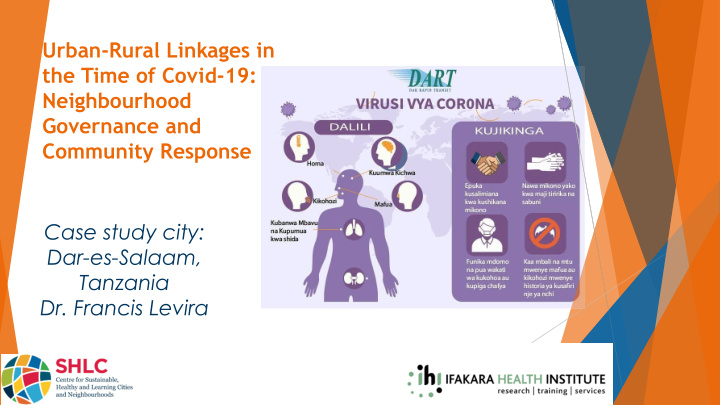



Urban-Rural Linkages in the Time of Covid-19: Neighbourhood Governance and Community Response Case study city: Dar-es-Salaam, Tanzania Dr. Francis Levira
Content Governance structures Neighbourhood classifications and urban-rural linkages Pandemic responses-Governance Pandemic responses-Preventive measures Pandemic responses-Treatment Challenges 2
Governance and health service structures in Tanzania Health services provision structure GOVERMENT OF TANZANIA PORALG Regional administration Rural Districts Urban Districts District / Municipal / City Township / Town Council Ward Ward Level Government Employee Political position District District Executive Director All sectors Member of parliament Ward Ward Executive Officer Health, education, community development Councilor and representative (not paid) Village Street Street Street Executive Officer Street chairman and representative (not paid) 3
Neighbourhood classification-Linkages Dar-es-salaam City: 6.4 mil Municipal Municipal Wards Street Wards Temeke 24 180 Street Kinondoni 27 171 Temeke Ilala 22 101 Kinondoni Kigamboni Ilala Ubungo Kigamboni Urban-Rural Linkages Ubungo -Labour market -Economic opportunities -Internal tourist -Education -Health seeking -Maintaining family ties Most urban migrants lives with relatives 4
Pandemic responses-Governance Establishment of three response committee National response committee: Inform the public on government measures. Under the leadership of Prime Minister: Vice President’s Office, Prime Minister’s Office (Minister & Permanent Secretary), Vice President’s Office Zanzibar, Ministers for Health (Mainland & Zanzibar), Defence, ST&HE, PORALG, Foreign Affairs, Minister for Finance (Mainland & Zanzibar) and Transport and Communication. Permanent Secretary’s committee: Advice the government Under the leadership of Chief Secretary: Members from ministries and offices listed above. National Taskforce: Advice Permanent Secretary’s committee Under the leadership of Permanent Secretaries from Ministries of Health (Mainland & Zanzibar): Technical team (WHO and other UN bodies, Donor Agencies, INGOs and local NGOs) Information management: COVID-19 statistics and directives provided to the public by either Minister for Health, Prime Minister or the President. 5
Pandemic responses-Preventive measures The government focused on infection prevention: NO LOCKDOWN (Household/City) Education campaigns through TV, Radio, Mobile Phones and neighbourhood at the level of Municipal Economic and social activities continued (Slow down were noted) Hygienic practices promoted at all service points (Hand washing, hand sanitizing, and wearing masks) Closure of all education institutions, sports events, and recreation facilities. Public gatherings limited (Weddings, funeral, religious events) Public transport regulations were instituted (Level seat on commuter buses) Last data release was 29 th April 2020. Total of 509 cases and 21 deaths reported. 6
Pandemic responses-Preventive measures 7
Pandemic responses-Treatment Three large public referral hospitals were designated for serious Corona patient. 24 sample collection facilities identified Initially designated hospitals lacked essential equipment to co-morbidities such as dialysis. Appropriate treatment hindered by stigma. Natural treatment were promoted (steam inhalation) NIMR released its natural treatment version to manage blood clotting (Hot pepper, ginger, lemon, onion, garlic, water) 8
Challenges Limited funding on education campaign and information sharing (Policy Forum, 2020) Lack of social support / subsidies to poor and vulnerable households (Policy Forum, 2020) Lack of technical capacity to diagnose COVID-19, testing conducted at 1 national lab Limited data needed to influence hygiene practice: Data available at regional level. Last data release was 29 th April 2020. Total of 509 cases and 21 deaths reported. Quarantine services such as food be improved to curb neighbourhood transmission Pandemics are unique, difficult to plan in advance Natural disaster such as floods and droughtremain the biggest urban-rural linkage disruptor. 9
Recommend
More recommend